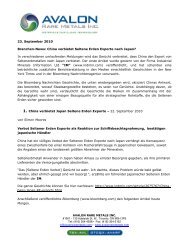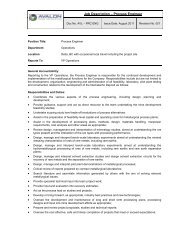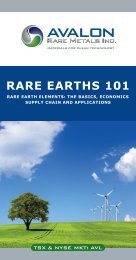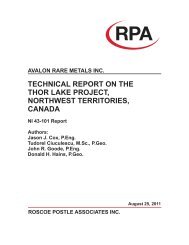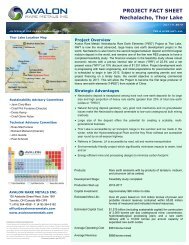technical report on the nechalacho deposit, thor lake project ...
technical report on the nechalacho deposit, thor lake project ...
technical report on the nechalacho deposit, thor lake project ...
Create successful ePaper yourself
Turn your PDF publications into a flip-book with our unique Google optimized e-Paper software.
CORE LOGGING AND CORE RECOVERY<br />
The REE-bearing minerals in <strong>the</strong> Nechalacho <strong>deposit</strong> are generally not visible with <strong>the</strong> naked<br />
eye due to <strong>the</strong>ir disseminated and fine-grained nature. The dominant minerals identified easily<br />
are zirc<strong>on</strong> and (infrequently) traces of bastnaesite although visual grade estimates of<br />
bastnaesite are rarely possible. To map <strong>the</strong> relative grades in <strong>the</strong> core Aval<strong>on</strong> utilizes a<br />
Thermo-Scientific Nit<strong>on</strong>® XLP-522K hand held analyzer for assistance to <strong>the</strong> geologist while<br />
core logging. The NITON ® energy-dispersive x-ray fluorescence (EDXRF) analyzers, comm<strong>on</strong>ly<br />
known as XRF analyzers, are able to quickly and n<strong>on</strong>-destructively determine <strong>the</strong> elemental<br />
compositi<strong>on</strong> of <strong>the</strong> drill core.<br />
A number of elements may be analyzed simultaneously by measuring <strong>the</strong> characteristic<br />
fluorescence x-rays emitted by a sample. EDXRF analyzers determine <strong>the</strong> c<strong>on</strong>tent of a sample<br />
by measuring <strong>the</strong> spectrum of <strong>the</strong> characteristic X-rays emitted by <strong>the</strong> different elements in <strong>the</strong><br />
sample when it is illuminated by X-rays, in <strong>the</strong> case of <strong>the</strong> XLP-522K, from a small, sealed<br />
capsule of radioactive material.<br />
Due to variati<strong>on</strong>s in analysis c<strong>on</strong>diti<strong>on</strong>s – <strong>the</strong> physical surface of <strong>the</strong> sample, <strong>the</strong> dampness of<br />
<strong>the</strong> sample, and <strong>the</strong> small window for analysis – <strong>the</strong> readings for individual elements cannot be<br />
c<strong>on</strong>sidered as quantitative and representing l<strong>on</strong>g core lengths. However, <strong>the</strong> readings can<br />
assist <strong>the</strong> geologist to identify mineralized secti<strong>on</strong>s, and determine whe<strong>the</strong>r <strong>the</strong>se secti<strong>on</strong>s are<br />
relatively higher or lower in heavy rare earth elements.<br />
Tests were completed to compare Nit<strong>on</strong> readings for a suite of ec<strong>on</strong>omically important elements<br />
in Nechalacho drill core to laboratory assays for two metre lengths of drill core. One test<br />
involved 24 readings over a two metre length of drill core compared to <strong>the</strong> laboratory analyses<br />
for that interval. The sec<strong>on</strong>d test was to complete between <strong>on</strong>e and four readings per two metre<br />
interval <strong>on</strong> two drill holes and compare to laboratory assays. Statistics was used to compare <strong>the</strong><br />
results from <strong>the</strong> Nit<strong>on</strong> with <strong>the</strong> laboratory analyses.<br />
For <strong>the</strong> test <strong>on</strong> <strong>the</strong> <strong>on</strong>e core interval, a <strong>on</strong>e-sample t-test was utilized to compare <strong>the</strong> Nit<strong>on</strong><br />
readings to analysis of <strong>the</strong> interval with <strong>the</strong> results illustrated in Table 11-1. The <strong>on</strong>e-sample t-<br />
test tests <strong>the</strong> null hypo<strong>the</strong>sis that <strong>the</strong>re is no significant difference. If <strong>the</strong> t-test gives a p-value<br />
greater than 0.05 it is taken that <strong>the</strong>re is no significant difference at <strong>the</strong> 95% c<strong>on</strong>fidence level.<br />
As can be seen in Table 11-1, <strong>the</strong> elements Sm, Nd, Y, Gd and Ce give str<strong>on</strong>g indicati<strong>on</strong>s of<br />
correlati<strong>on</strong> between <strong>the</strong> assay values and Nit<strong>on</strong> readings. Nb, La, Dy and Pr give weaker results<br />
and Fe, Eu, Ta, Tb and Th give unacceptable results.<br />
The sec<strong>on</strong>d test compared Nit<strong>on</strong> readings with <strong>on</strong>e to four per interval over two drill holes, L07-<br />
52 and 61A, which were used to compare laboratory analyses against individual Nit<strong>on</strong> analyses<br />
using a two sample t test and regressi<strong>on</strong> for paired samples. This test also gave acceptable<br />
Technical Report 43-101 – March 13, 2011 Page 11-5<br />
Prepared by Aval<strong>on</strong> Rare Metals Inc.







